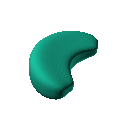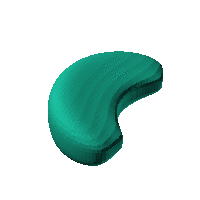The blob in all its glory:
 Twirl with your mouse
Twirl with your mouse
A boxy crescent with lots of potential as a container.
|
Click on the snapshot to download the blob's stl file.
|

|
Octave Code:
# name of the blob
project = "blob39";
function w = f(x2,y2,z2,c,r,e)
x = (x2-c(1))/r(1); # do some simple scaling
y = (y2-c(2))/r(2);
z = (z2-c(3))/r(3);
# function at origin must be <0, and >0 far enough away. w=0 defines the surface
w = x.^4+y.^4+z.^4-1; # <<<<<<<<<<< THE BLOB FUNCTION
endfunction;
# do the scaling
c_outer = [15,0,0]; # center of ellipsoid for outer surface
r_outer = [60,180,39];# x,y,z radii for ellipsoid for outer surface
step = 4; # grid pitch in mm start with 4mm to see the shape quickly. Once you have it just right, change to 2mm for printing
xmin = floor(-75);
xmax = floor(175);
ymin = floor(-120 );
ymax = floor(120 );
zmin = floor(-50 );
zmax = floor(50 );
# this is for distorting the grid before applying the function
# note that the undistorted grid will be used to make the stl file
# just set it to x3=x; y3=y; z3=z; if no warping is needed.
function [x3,y3,z3]= prewarp(x,y,z)
R =200; # center of sphere is at (R+X0,0,0) with radius R (passing through (X0,0,0) )
X0 = 60; # this means that parts of the blob near [X0,0,0] will stay near that point.
# calculate the inverted coordinate of each point in the 3D grid (x3,y3,z3)
x2 = x-R-X0; y2=y; z2 = z; # intermediate values
r2 = R*R./(x2.^2+y2.^2+z2.^2);
x3 = x2.*r2+R+X0; y3 = y2.*r2; z3 = z2.*r2;
endfunction;
source("../octave/func2stl_v01.m"); # do all the calculations
GNU Octave




 Twirl with your mouse
Twirl with your mouse

